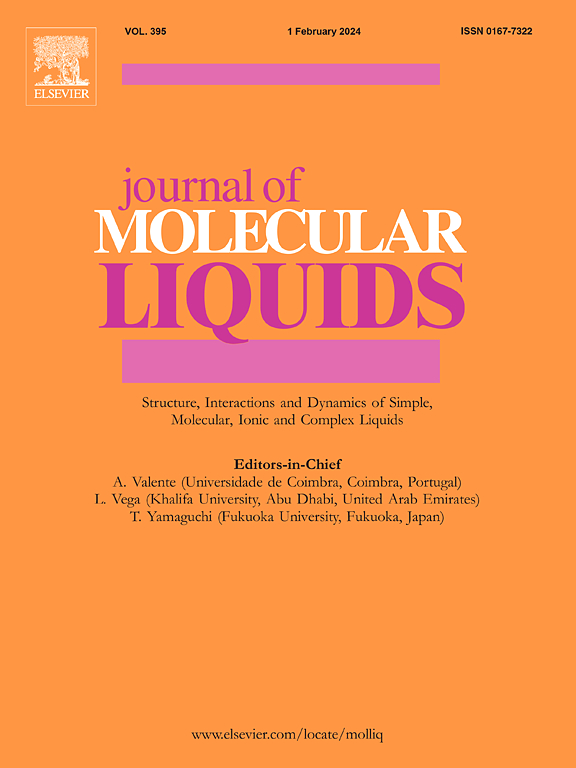Molecular dynamics simulation of polyethylene glycol-based deep eutectic solvents: Microstructure, dynamics and potentials for curcumin delivery
IF 5.3
2区 化学
Q2 CHEMISTRY, PHYSICAL
引用次数: 0
Abstract
Deep eutectic solvents (DESs) based on polyethylene glycol (PEG) are a new class of green solvents. Their low toxicity, cost-effectiveness, straightforward synthesis, and tunable properties make them highly promising for various technological applications. However, the molecular-level participation of PEG in the formation of DESs remains insufficiently understood. In this study, molecular dynamics (MD) simulations were employed for the first time to investigate a DES composed of tetrabutylammonium bromide (TBAB) and PEG8. The simulation results showed that strong hydrogen bonding interactions between bromine and the hydroxyl group of PEG8 play a pivotal role in DES formation. To assess the system's potential for solubilizing hydrophobic compounds such as curcumin, the structure of curcumin was simulated in PEG8-based DES. The results confirm the efficacy of these solvent systems in solubilizing curcumin and using them in curcumin-delivery pharmaceutical systems.
聚乙二醇基深共晶溶剂的分子动力学模拟:姜黄素传递的微观结构、动力学和潜力
聚乙二醇(PEG)为基础的深共晶溶剂(DESs)是一类新型的绿色溶剂。它们的低毒性、低成本、简单的合成和可调的性质使它们在各种技术应用中具有很大的前景。然而,PEG在分子水平上参与DESs的形成仍然没有得到充分的了解。本研究首次采用分子动力学(MD)模拟研究了四丁基溴化铵(TBAB)和PEG8组成的DES。模拟结果表明,溴与PEG8羟基之间的强氢键相互作用在DES的形成中起着关键作用。为了评估该体系对疏水化合物(如姜黄素)的增溶潜力,在PEG8-based DES中模拟了姜黄素的结构。结果证实了这些溶剂体系对姜黄素的增溶效果,并将其用于姜黄素递送的药物体系中。
本文章由计算机程序翻译,如有差异,请以英文原文为准。
求助全文
约1分钟内获得全文
求助全文
来源期刊

Journal of Molecular Liquids
化学-物理:原子、分子和化学物理
CiteScore
10.30
自引率
16.70%
发文量
2597
审稿时长
78 days
期刊介绍:
The journal includes papers in the following areas:
– Simple organic liquids and mixtures
– Ionic liquids
– Surfactant solutions (including micelles and vesicles) and liquid interfaces
– Colloidal solutions and nanoparticles
– Thermotropic and lyotropic liquid crystals
– Ferrofluids
– Water, aqueous solutions and other hydrogen-bonded liquids
– Lubricants, polymer solutions and melts
– Molten metals and salts
– Phase transitions and critical phenomena in liquids and confined fluids
– Self assembly in complex liquids.– Biomolecules in solution
The emphasis is on the molecular (or microscopic) understanding of particular liquids or liquid systems, especially concerning structure, dynamics and intermolecular forces. The experimental techniques used may include:
– Conventional spectroscopy (mid-IR and far-IR, Raman, NMR, etc.)
– Non-linear optics and time resolved spectroscopy (psec, fsec, asec, ISRS, etc.)
– Light scattering (Rayleigh, Brillouin, PCS, etc.)
– Dielectric relaxation
– X-ray and neutron scattering and diffraction.
Experimental studies, computer simulations (MD or MC) and analytical theory will be considered for publication; papers just reporting experimental results that do not contribute to the understanding of the fundamentals of molecular and ionic liquids will not be accepted. Only papers of a non-routine nature and advancing the field will be considered for publication.
 求助内容:
求助内容: 应助结果提醒方式:
应助结果提醒方式:


